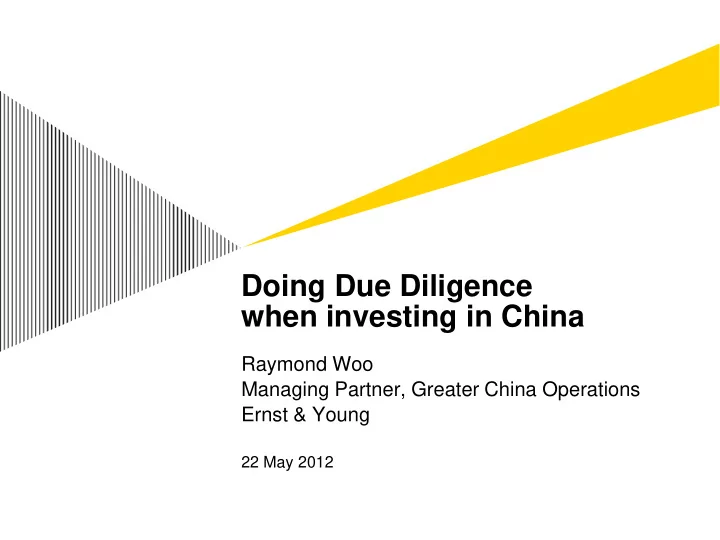

Doing Due Diligence when investing in China Raymond Woo Managing Partner, Greater China Operations Ernst & Young 22 May 2012
China remains a hotspot for inbound FDI 120 100 80 60 40 USD’billion 20 FDI Inbound 0 FDI Outbound 20 40 60 80 2006 2007 2008 2009 2010 Source: UNCTAD (United Nations Conference on Trade and Development), 24 October 2011 ► China’s GDP reached USD7.3 billion in 2011, second only to the US. ► Financial crises reduced 2009 FDI to China to USD90 billion, not because of lower market prospects, but because of financial problems of the investors. ► Rising income and demand for luxury goods will continue to attract FDI to China in 2011 and 2012, as inbound FDI reached USD105 billion in 2010. Page 1 Page 1 Presentation title
E&Y is active in China’s M&A market Typical M&A deals in China Type of Target Company Business Company Deal stake ► Shandong Lingong Wheel Loader POE Majority ► Tianhe Chemicals Specialty Chemical POE Minority ► Golden Jaquar Restaurant Chain POE Majority ► POVOS Electric Appliance Kitchen Appliance POE Majority ► Dabao Cosmetics SOE Majority ► Fujian Sedrin/ KK Brewery Breweries SOE Majority and Huaneng Debier/ Yangji Nuobao Minority Harbin Brewery/ Tsingtao Brewery Zhejiang Shiliang ► Yashili Dairy products POE Minority ► Web Education POE Minority Page 2 Page 2 Presentation title
Due Diligence issues varies from transaction to transaction Typical DD objectives Typical DD issues ► Identify deal breakers early ► Accounting errors and ► Gather relevant information differences ► Quality of earnings for informed decisions ► Liability exposure ► Valuation ► Fraud and unscrupulous ► Deal structure business practices ► Valuation gap ► Liabilities exposure ► Other transaction issues ► Funding requirements ► Representation & warranties ► Representation & warranties ► Price adjustments Page 3 Page 3 Presentation title
Typical due diligence issues ► Accounting errors and differences ► Revenue recognition ► Cash vs accrual basis of accounting ► Accounting estimates ► Doubtful debts ► Obsolete stocks ► Warranties ► Staff benefits ► Other GAAP differences ► Not uncommon to see profits reduced by 20 + % after DD adjustments Page 4 Page 4 Presentation title
Typical due diligence issues ► Quality of earnings - sustainability ► Cost structure ► Product mix and profit margins ► Cost-to-income ratio ► Sensitivity analysis ► One-off adjustments ► Stand alone adjustments ► Related party transactions ► Analysis is limited by ► Free access to people and information ► Use of manual accounting system ► Design of chart of accounts Page 5 Page 5 Presentation title
Typical due diligence issues ► Liability exposure Transaction tax rates ► Contingent and off balance sheet liabilities ► Cross-guarantees Asset deal ► Onerous contracts ► VAT @ 2 or 17% on fixed ► Commitments assets (pre or post 2009) ► Land use rights ► BT @ 5% on intangibles ► Tax exposure ► RPGT @ 30-60% on gains ► Multi-sets of books ► CIT @ 25% on profits ► Negotiated tax rebates ► Improper CIT/ BT tax adjustments Share deal ► Customs duty – under-declare import ► Stamp duty @ 0.05% on value price and misuse of bonded materials ► Under-reporting of IIT ► Capital gain tax @ 25% for domestic seller, @ 10% for ► Penalty: up to 5 times (with no foreign seller. statutory bar) ► Share deal or asset deal? Page 6 Page 6 Presentation title
Typical due diligence issues ► Fraud and unscrupulous business practices ► Inflated sales ► Fictitious transactions and assets ► Complex distribution channels ► Undisclosed liabilities ► Kick-back and bribery ► US: FCPA; UK: Commercial bribery Page 7 Page 7 Presentation title
Typical due diligence issues ► Valuation gap Average PE of major stock indices ► Acquisition is expensive: average PE multiple 25 X to Dec 31, 2010 50X ► SOEs can’t sell below 90% of prescribed valuation Dec 31, 2009 ► Need to have deep understanding of assumptions underlining projections and valuation model Dec 31, 2008 0.0 0.0 5.0 10.0 15.0 20.0 25.0 30.0 35.0 40.0 5.0 Dow Jones S&P 500 Hang Seng Shenzhen-A Shanghai-A PE of Shenzhen PE zhen Composite osite is higher er than Hang Seng’s and S&P 500’s and has rebounded ounded faster er Page 8 Page 8 Presentation title
Key take away…………… ► China is a developing market, transaction issues not peculiar to China ► China is big – one size doesn’t fit all ► Diverse in geography and demographic ► 56 minorities, 200 dialects, in 22 provinces ► Internal alignment is important ► China vs HQ team ► Division, finance and legal teams ► Involve advisers early ► Don’t limit scope of DD ► Don’t get “trapped” in the “This is how it’s done in China” syndrome ► Doing transaction in China takes time (can take 3X + longer) ► Patience, patience, patience ……… Page 9 Page 9 Presentation title
Recommend
More recommend